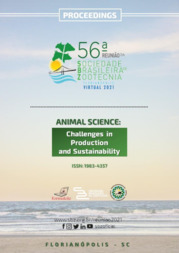Methodologies for measuring the dry matter content in samples of different purpose sorghum silages.
Methodologies for measuring the dry matter content in samples of different purpose sorghum silages.
Author(s): SILVA, M. E. A. da; SILVA, D. P. S. da; MACEDO, T. de F. de; BEHLING NETO, A.; PEREIRA, D. H.; TARDIN, F. D.
Summary: In order to guarantee the production of feed for ruminant animals, the dry matter (DM) content determination is very common in laboratories routine. For silage samples, part of the fermentation products can be lost by volatilization, therefore, the correction of the DM content is necessary to obtain the appropriate water content. In Europe, the formula determinated by Weissbach and Strubelt (2008) is widely used to correct this variable in corn and grass silage, since it follows a specific drying method, which is described by these authors, however, in Brazil the main methodology used to determine the content of feed DM is the described by Dettman et al. (2014). Despite this, there are few studies comparing these assessment methods to see whether in Brazil, this methodology can or cannot be used to correct the content of DM in silages. Thus, the goal was to assess whether there is a difference in obtaining the DM content with these two methodologies in sorghum silages samples. The field experiment was developed at Embrapa Agrossilvipastoril, while the analyzes were carried out at the Forragiculture Laboratory of the Federal University of Mato Grosso, Campus Sinop-MT. The design used was a 4x2 factorial, with four types of sorghum (Grain - BRS 373; Forage - BRS 658, Biomass - BRS 716; Sweet - experimental access) and two drying methodologies [Dettman et al. (2014): pre-drying in a forced ventilation oven at 55ºC, for 72 h, to determine the DM content of air-dried sample (ASA) and in an oven at 105ºC, for 16 h, to determine the DM content of the oven dried sample (ASE); Weissbach and Strubelt (2008) where the drying is done in a forced ventilation oven at 60ºC, for 18 h (ASA), and in an oven at 105ºC, for 3 h (ASE)]. The definitive DM content was determined by the multiplication of ASA by ASE for both methodologies. The data obtained were subjected to analysis of variance and the means compared by the LSD test, adopting a probability level of 5%. Regarding ASE, an interaction effect between methodology and type of sorghum was observed. However, for ASA and the definitive DM content, only the effect of sorghum purpose was observed, with higher value for grain sorghum, with 37.78 and 35.64% respectively, and lower for biomass sorghum, with 18.72 and 17.49%, respectively. Forage and sweet sorghum had a definitive DM content of 28.90 and 28.55%, respectively. There was no effect of the methodology on the definitive DM value content for all sorghums. We conclude that we can use the methodology of Dettman et al. (2014) for drying silage samples in Brazil and apply the formula for correcting the DM content for volatile compounds used by Weissbach and Strubelt (2008).
Publication year: 2021
Types of publication: Abstract in annals or event proceedings
Observation
Some of Embrapa's publications are published as ePub files. To read them, use or download one of the following free software options to your computer or mobile device. Android: Google Play Books; IOS: iBooks; Windows and Linux: Calibre.
Access other publications
Access the Agricultural Research Database (BDPA) to consult Embrapa's full library collection and records.
Visit Embrapa Bookstore to purchase books and other publications sold by Embrapa.

